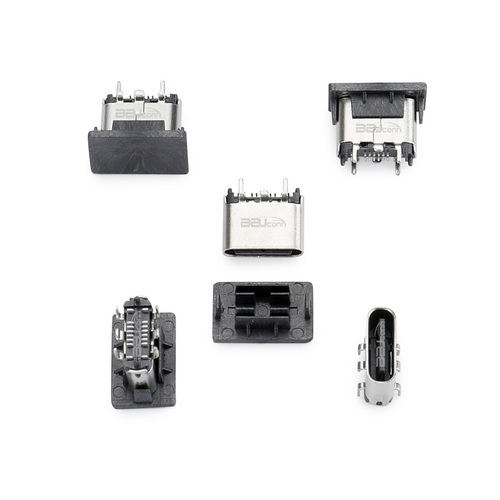Medical-grade waterproof Type-C sterilization solution: Ethylene oxide penetration test and sealing ring selection
发布时间:2025-03-26作者:Shenzhen BBJ technology co., LTD点击:337
Medical-grade waterproof Type-C sterilization solution: Ethylene oxide penetration test and sealing ring selection
With the continuous development of medical equipment and the increase in modernization needs, the waterproofness, sterilization ability and connection safety of medical equipment have received more and more attention. As a modern interface method, the Type-C interface has gradually been used in medical equipment due to its high efficiency, stable transmission ability and wide adaptability. In order to ensure the safety and reliability of the Type-C interface in the medical environment, especially the waterproofness during the sterilization process, ethylene oxide (ETO) penetration test and the selection of sealing rings have become key links in the design.
1. Ethylene oxide penetration test
Ethylene oxide (ETO) sterilization is a technology widely used in medical device sterilization, especially for sensitive devices that cannot withstand high temperature or moisture. The process of ethylene oxide sterilization usually involves high temperature and pressure, and gas may penetrate into the device during the sterilization process, affecting the structure and function of the device.
Therefore, for Type-C interface devices, conducting ethylene oxide penetration testing is a key step to ensure that the device will not be contaminated during the sterilization process. The main purpose of the ethylene oxide permeation test is to simulate the ability of ethylene oxide gas to penetrate through the device interface and housing during the sterilization process, so as to evaluate the sealing and waterproofness of the device design.
Test method:
Sample preparation: Select a Type-C interface device that has been preliminarily designed, and ensure that all its waterproof designs meet the expected standards.
Simulated sterilization conditions: Place the device in an ethylene oxide sterilization environment to simulate the temperature, humidity, gas concentration and other conditions in the actual sterilization process.
Detection of permeability: Through gas concentration monitoring, pressure testing and other means, observe whether ethylene oxide gas penetrates into the device through the interface or device housing, especially internal sensitive components such as circuit boards and sensors.
Result evaluation: If the penetration exceeds the standard value, it means that there is a problem with the design, and the sealing design, especially the adaptability of the interface and the sealing ring, needs to be re-evaluated.
Through the ethylene oxide permeation test, the safety of the Type-C interface during the sterilization process can be effectively evaluated to ensure that the device will not be contaminated or corroded by gas during the sterilization process, thereby ensuring its normal operation.

2. Selection of sealing rings
The sealing ring is a crucial component in waterproof design, especially for medical equipment. The sealing ring needs to be not only waterproof, but also effectively prevent the penetration of ethylene oxide gas. Therefore, the selection of the sealing ring must consider many factors, such as material, size, shape, high temperature resistance, corrosion resistance, etc.
1. Material selection:
Silicone: Silicone sealing rings are often used in medical equipment due to their good temperature resistance and biocompatibility. Silicone has excellent corrosion resistance, can maintain stable physical properties during ethylene oxide sterilization, and adapt to high temperature and high humidity environments.
Fluororubber (FKM): Fluororubber sealing rings have strong chemical resistance and high temperature resistance, and are particularly suitable for use in ethylene oxide sterilization environments. It can effectively prevent gas penetration and has extremely high tolerance to high temperatures and chemical reagents.
EPDM rubber (Ethylene Propylene Diene Monomer): EPDM rubber has good weather resistance and chemical resistance, and is suitable for medical equipment that requires long-term durability and oxidation resistance. Its moisture and oil resistance make it ideal for ethylene oxide sterilization.
2. Sealing ring size and shape: The size and shape of the sealing ring must closely match the design of the Type-C interface to ensure the sealing effect. The compression degree and shape design of the sealing ring must be able to effectively fill the gap between the interface and the shell to form a reliable seal. Common sealing ring shapes include O-type, X-type, etc., which need to be selected according to the specific interface form.
3. Temperature resistance and corrosion resistance: The sealing ring needs to be able to withstand the effects of high temperature, high humidity and chemical corrosion during ethylene oxide sterilization. To this end, the material of the sealing ring must have good high temperature resistance and keep its physical properties unchanged in a high temperature environment to prevent sealing failure due to thermal expansion or aging.
4. Installation and maintenance: The installation of the sealing ring should be simple and convenient, not affect the overall structure of the equipment, and not easy to deform or fail during long-term use. Regular inspection and maintenance can also ensure that the sealing ring maintains its good sealing effect during high-frequency sterilization.
3. Summary
In medical devices, the waterproofness and sterilization performance of the Type-C interface are crucial to ensuring the safety of the device. The ethylene oxide penetration test can effectively verify the sealing and waterproofness of the device to ensure that the device is not contaminated during the sterilization process. The selection of the sealing ring is one of the core of waterproof design. The correct material, size, shape and performance requirements directly determine the long-term reliability and safety of the device. Medical device designers should fully consider these factors when selecting materials and designs to ensure that the device can operate efficiently and safely in an ethylene oxide sterilization environment.